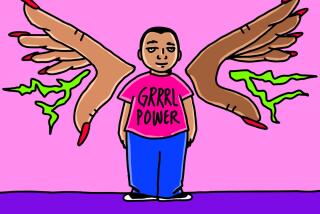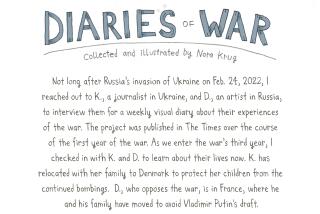Dagmar Wilson dies at 94; organizer of women’s disarmament protesters
In 1961, the Berlin Wall went up, the Cold War arms race was on and Dagmar Wilson, a storybook illustrator and mother of three, steamed into the national spotlight.
A self-described “non-joiner,” Wilson sparked a movement that on Nov. 1, 1961, drew an estimated 50,000 women across the country out of their homes and offices and into the streets to demonstrate for disarmament. Women Strike for Peace, the loose network of activists she founded, mounted the largest national women’s peace protest of the 20th century and helped push the United States and the Soviet Union into signing a nuclear test-ban treaty two years later.
The protesters were not radicals, although Red hunters tried to portray them as such — and failed miserably. They were, like Wilson, well educated, middle-class women in white gloves and tasteful hats who were impelled by fears of radioactive milk and impatience with the men who ran peace groups and governments.
“You know how men are. They talk in abstractions and the technicalities of the bomb, almost as if this were all a game of chess. Well, it isn’t,” Wilson said shortly after the protest. “There are times, it seems to me, when the only thing to do is let out a loud scream.... Just women raising a hue and cry against nuclear weapons for all of them to cut it out.”
Wilson, who was active in Women Strike for Peace through the early 1970s, died of natural causes Jan. 6 in Washington, D.C., said her daughter Sally M. Ballin. She was 94.
Born Dagmar Searchinger in New York City on Jan. 25, 1916, she grew up in Europe, where her father was a CBS radio correspondent. She graduated in 1937 from the Slade School of Fine Art in London. Soon after she married Christopher Wilson and moved to Washington, where he was a British Embassy officer.
When the ‘60s dawned, she was raising three girls and managing a busy career illustrating children’s books. She eventually had 50 titles to her credit, including the classic “Poems to Read to the Very Young,” published in 1961.
In September of that year, philosopher Bertrand Russell, then 89, was arrested for his part in an anti-nuclear bomb demonstration at London’s Trafalgar Square. The night of the arrest Wilson and her husband were hosting a cocktail party at which she expressed her anger at Russell’s jailing. “I felt like chartering a plane and going over to picket the jail,” she said, but none of her guests seemed to share her alarm.
The next day she began calling every woman she knew. Soon afterward, a small group met in her living room. They decided to call themselves Women Strike for Peace and conceived a plan for women to leave their jobs and kitchens for a day in protest of what they believed was impending planetary crisis. Word spread through church groups, PTA networks and women’s clubs, and six weeks later tens of thousands of women in 60 cities, including 4,000 women in Los Angeles, were mobilized.
President Kennedy watched from a White House window as Wilson’s group of 1,500 women demonstrated at the foot of the Washington Monument. That day, the group sent letters to the first lady, Jacqueline Kennedy, and her Soviet counterpart, Nina Khrushchev, imploring them to speak to their husbands about disarmament.
At a news conference two months later, the president said he had received the message of these “extremely earnest” women who were “concerned as we all are of the possibility of nuclear war.” In 1963 he signed a partial nuclear test-ban treaty with the Soviet Union.
Wilson’s high visibility in the protest made her a target of the House Un-American Activities Committee, which subpoenaed her in 1962 along with other Women Strike for Peace members. Dozens of women packed the hearing, turning a somber inquisition into brilliant guerrilla theater.
Whenever a woman rose to testify, another woman rose to present her with a flower, and when she was done speaking, she received hugs, kisses and applause. When Wilson’s turn came, she was given a full bouquet.
She used humor to resist the committee’s efforts to smear her as a Communist sympathizer. Would she, the committee asked, allow Nazis or fascists to join the organization? “If only we could get them!” she replied. Would she permit Communists to hold leadership positions in the group? “Unless everyone in the world joins in this fight, then God help us.”
The next day’s headlines were not flattering to the committee, which had destroyed the reputations of many men and women over the previous decade. One headline was particularly succinct: “Peace Gals Make Red Hunters Look Silly.”
Wilson said later that her appearance before the committee was probably “the one great moment of my life.”
By the end of the decade, a new generation of activists focused on U.S. involvement in Vietnam had flowered. Wilson withdrew to a quieter life as a landscape painter in Loudoun County, Va., where she was involved in local environmental and peace groups.
In addition to Ballin, of Burlington, Vt., she is survived by daughters Clare Wilson of Silver Spring, Md., and Jessica Wilson of Mt. Gilead, Va.; two grandchildren; and two great-grandchildren.
One of Wilson’s last major acts for Women Strike for Peace was a peace mission to Hanoi in 1967, shortly after U.S. bombs began to fall on the city. In the book “The Price of Dissent,” a 2001 collection of oral histories by Bud Schultz and Ruth Schultz, she described waiting by a bombed-out bridge on a moonlit night and recalling how she had gazed “at the same darn moon” before leaving Georgetown two weeks earlier.
“It just gave me an uncanny, ‘one-planet’ feeling,” she said. “We live together on one Earth. Can we do it in peace? I still cherish that dream.”
More to Read
Start your day right
Sign up for Essential California for the L.A. Times biggest news, features and recommendations in your inbox six days a week.
You may occasionally receive promotional content from the Los Angeles Times.







